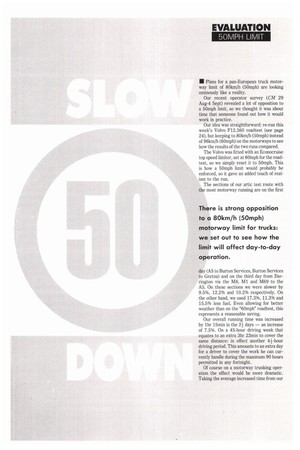• Plans for a pan-European truck motorway limit of 80km/h (50mph) are looking ominously like a reality.
Page 42

Page 44

If you've noticed an error in this article please click here to report it so we can fix it.
Our recent operator survey (CM 29 Aug-4 Sept) revealed a lot of opposition to a 50mph limit, so we thought it was about time that someone found out how it would work in practice.
Our idea was straightforward: re-run this week's Volvo F12.360 roadtest (see page 24), but keeping to 801cm/h (50mph) instead of 96km/h (60mph) on the motorways to see how the results of the two runs compared.
The Volvo was fitted with an Econocruise top speed limiter, set at 60mph for the roadtest, so we simply reset it to 50mph. This is how a 50mph limit would probably be enforced, so it gave an added touch of realism to the run.
The sections of our artic test route with the most motorway running are on the first day (A5 to Burton Services, Burton Services to Gretna) and on the third day from Darrington via the M8, M1 and M69 to the A5. On these sections we were slower by 9.5%, 12.2% and 10.2% respectively. On the other hand, we used 17.3%, 11.3% and 15.5% less fuel. Even allowing for better weather than on the "60mph" roadtest, this represents a reasonable saving.
Our overall running time was increased by 11u15min in the 21 days — an increase of 7.5%. On a 45-hour driving week that equates to an extra 3hr 23min to cover the same distance: in effect another 41-hour driving period. This amounts to an extra day for a driver to cover the work he can currently handle during the maximum 90 hours permitted in any fortnight.
Of course on a motorway trunking operation the effect would be more dramatic. Taking the average increased time from our three motorway based sections as 10.6%, the increase over the same 90 hours would be around 91 hours, and that's without any delays. For a big fleet the extra cost would be appreciable.
Against this, an operator would have to weigh up the saving in fuel. As our results show, we used 38 litres less fuel; a saving of 8.1%. This represents about 4,000 litres a year for a vehicle covering 120,000km.
A motorway trunking route would inevitably generate more fuel savings than an urban route where the reduced limits would not have any effect: the average fuel saving over our three motorway sections worked out at 14.7%.
Statistics don't tell the whole story of course. The practicalities of driving a vehicle that cannot travel faster than 80km/h (50mph) must also be taken into account. Certainly, most cars on motorways are driven appreciably faster than trucks, but plenty of cars trundle along between 64km/h and 96km/h (40-60mph).
When a truck attempts to pass another vehicle travelling only slightly slower than it is, a frustrating and potentially hazardous situation can develop. On more than one occasion it took several minutes for us to overtake at our restricted 50mph, and on a two-lane motorway this resulted in a long tailback of cars waiting to get past.
It's not hard to extrapolate the effect on traffic flows if every LGV on every motorway in Britain was restricted to 50mph. Huge numbers of frustrated truck drivers would spend much of their time in the overtaking lane and, on two-lane motorways in particular, the result would be chaos as angry car drivers were forced to travel 20mph slower than they are allowed to (and more like 30mph below their usual cruising speed).
Apart from overtaking it must be said that 50mph motorway cruising was a quiet, relaxed experience, although without the help of the limiter holding the Volvo at 80kmili (50mph) would have entailed constant clock watching.
The Volvo's 262kW (356hp) was more than adequate for the lower limit so another likely consequence would be a slow-down in demand for higher powered tractive units. Only an increase in weight limits would increase demand again, and that hardly seems likely at the moment.
On balance the cost of a 50mph limit is hard to quantify. Against the increase in man hours and time spent away from home, hauliers would benefit from reduced fuel consumption and running costs. They could justifiably claim to be doing their bit for the environment too, as the fuel savings would result in a lower level of exhaust emissions from trucks (although increased journey times and traffic congestion might cancel out much of that benefit). In any case, such arguments are unlikely to cut any ice with clients who are demanding faster and cheaper deliveries.
LI by John Kendall




























































































